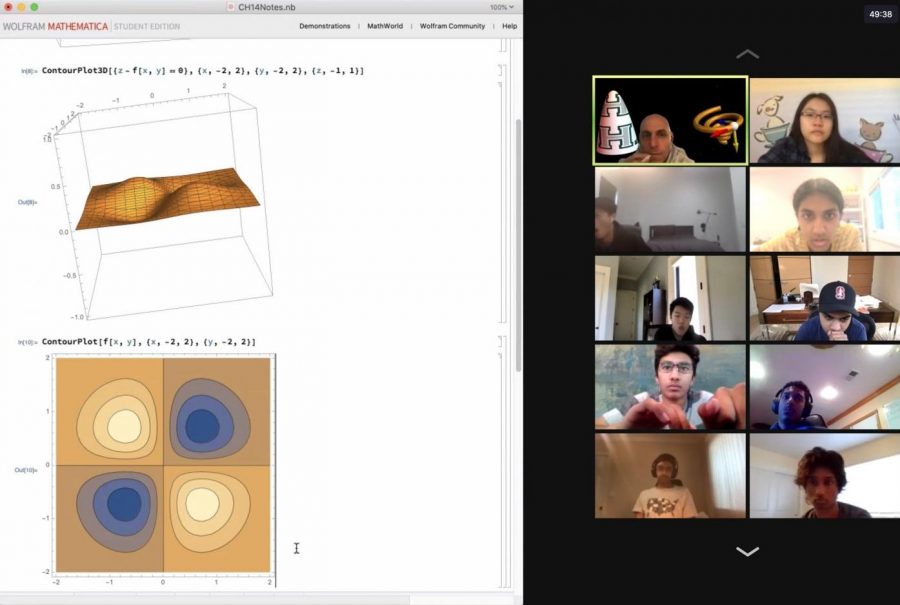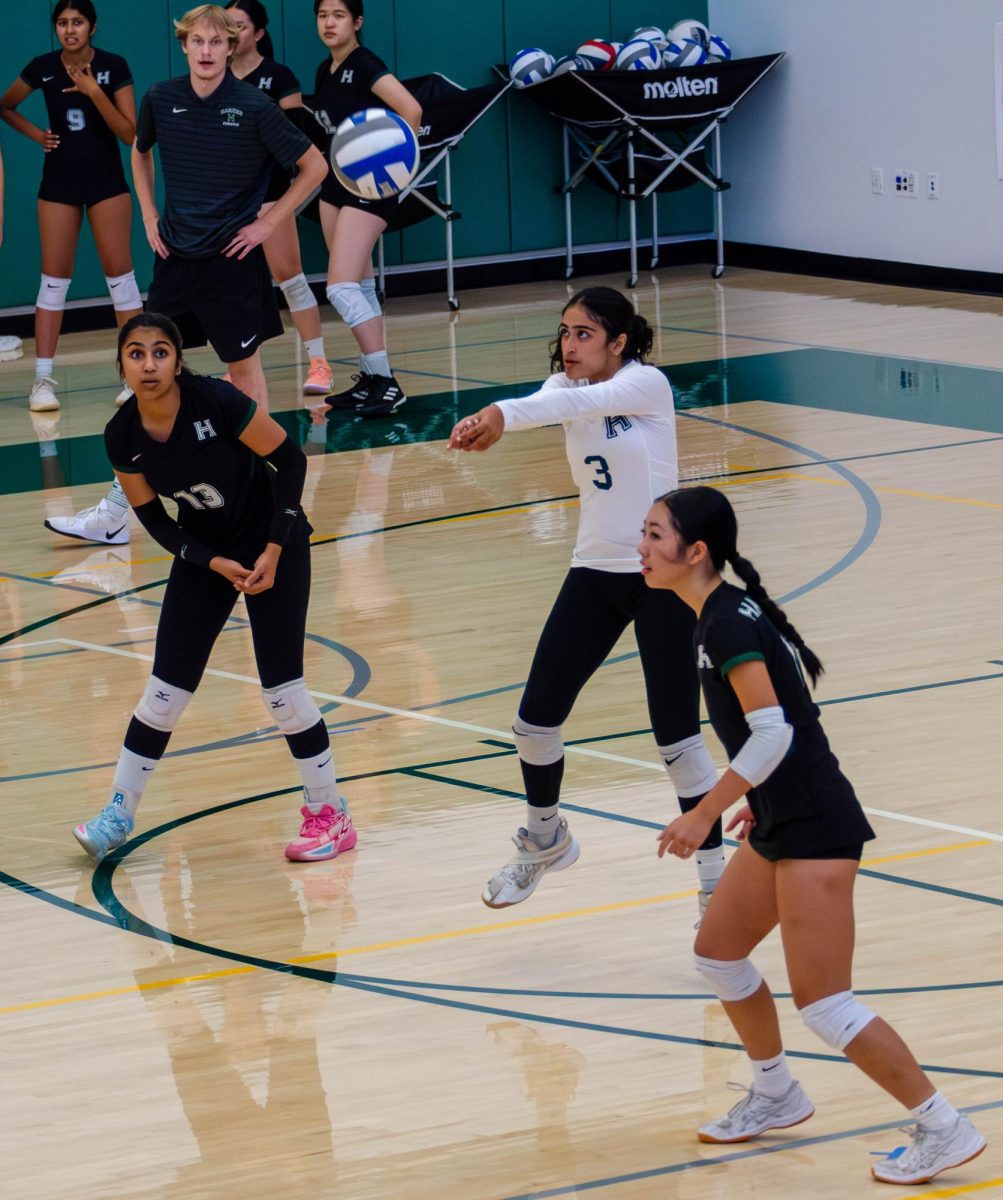STEM classes embrace technology to adapt to online learning
Students in Dr. Adler’s Multivariable calculus class use Mathematica, a tool capable of visualizing, analyzing and manipulating complex graphs among other functionalities, to graph three-dimensional curves. Students also use the software for long-form projects to better understand more difficult topics.
October 19, 2020
As the upper school continues in remote fashion for the first semester of the 2020-2021 school year, teachers of STEM classes have adopted new teaching methodologies while adapting old ones in order to create a productive learning environment.
Well aware of the importance of student engagement, teachers have experimented with methods that encourage or require students to actively participate in class discussions. Teachers hope that these methods will make sure students stay focused during class and complete the required work inside and out of the virtual classroom.
Upper school science teacher Chris Spenner, who teaches Research Methods, Advanced Research and AP Physics C, has accommodated his teaching methods to better suit his students this year, who cannot perform the same lab activities that they would at school.
“I’ve had to change quite a bit, because part of the training is to have [students] do hands on measurements and experiments in the lab using equipment that they can’t have access to at home,” he said. “The same is true in physics. They normally would be doing group experiments in the lab, which is extremely valuable.”
Spenner has adjusted his classes to include more statistical work, which students can perform without sophisticated lab equipment.
“What I’m doing more of is having them do very simple measurements at home to try to get some experience with that kind of experimental design and work. I’m also adding on a lot more quantitative analysis, so more statistics, more working with big data sets and more thorough analysis of those data sets.”
For his AP Physics C students in particular, Mr. Spenner has used videos in order to assist students in learning concepts that require visual aids, which would normally be supplied by labs in class.
“In Physics, there’s a website called Pivot Interactives; I’m not requiring my students to use those [videos], but those are available for them if they want to use them. I also make some of my own custom videos of both lectures and demonstrations,” Spenner said.
Pivot Interactives in particular has been useful to help Spenner’s students practice taking measurements and performing labs virtually.
“It acts as a review of basic course content… also, since their online modules are interactive, you can manipulate a measuring device, collect data and analyze the data – it’s pretty well aligned with what the College Board expects them to be able to do with data,” Spenner said.
In comparison to his AP Physics C course, Spenner has kept most aspects of his Advanced Research curriculum more constant.
“For Advanced Research in particular, I needed to make very few changes to the curriculum because the curriculum was designed from the start to be more flexible, very student driven and very independent,” Spenner said. “Even in previous years, a lot of students already had out-of-school projects going on that they didn’t use our current research lab for.”
Betsy Tian (12), who takes Advanced Research, values the encouraging environment of the class, which is still pervasive in remote learning.
“I feel like the nature of the class itself is very collaborative. And one reason it’s able to be so collaborative is the fact that it’s a class that everybody’s taking because they’re so interested in learning about other people’s science,” she said. “I think it’s one of the reasons why we all try to seek out those opportunities, even if we’re still online. I know Mr. Spenner encourages us to read one another’s work for peer review. I think those are all ways that encourage collaboration.”
Betsy believes that maintaining interactions with others is beneficial to performing effective research.
“I think when you’re working on a research project in isolation it does make the process naturally more difficult,” she said. “I find that not only at school but also in general this past summer when I was working on a research project by myself, just the process of, for example, going to see the postdoc I’m working with, being able to talk to my mentors, and being surrounded by other scientists who are also working on really interesting projects [was helpful].”
Upper school math teacher Victor Adler, who teaches Multivariable Calculus (MVC), has continued to use Mathematica, a tool capable of visualizing, analyzing and manipulating complex graphs among other functionalities, to teach his students.
“I’ve always had Mathematica, and that hasn’t really changed at all. There’s Zoom and its whiteboard, but Mathematica has been and will be for the foreseeable future, the tool of choice for my class,” he said.
However, Dr. Adler has adapted his teaching style to ensure that his students remain engaged in class.
“Where I wouldn’t normally cold-call kids in a regular classroom, I do in remote [learning], just to make sure that they’re paying attention,” Adler said. “I also request that people share more frequently, so the biggest change is making sure that people are engaged through active sharing, cold calling and requesting that they share their screens to do Mathematica,” he said.
Sasvath Ramachandran (11), who takes MVC with Adler, has found the required conversation to be more helpful in learning concepts.
“Online, it’s a lot harder to have a back and forth because kids in general are more reluctant to talk,” Sasvath said. “I think [when] one of the students shares their screen and shows what they’re doing on Mathematica, there’s the key component of the back and forth that gets you to learn the concept, and figuring it out on your own as opposed to just giving it to you.”
Sasvath has found it more useful than ever to continue taking notes during class in order to pay attention.
“If you don’t have something else in front of you, you can easily get distracted. That’s why it’s helpful to have a textbook close by or take notes by hand where, at least if you get distracted, you get distracted in a way that you can come back easily,” he said. “If you’re taking notes and you start doodling or something, it’s easy to come back, as opposed to being on Reddit. It’s basically just having some tangible aspect to the learning.”
Overall, Adler understands that this year may be challenging for both teachers and students and hopes to make the experience as smooth as possible.
“It’s certainly not going to be optimal. I would rather be in person for sure. But clearly, this is the safest option we have. And I’m hoping the students seize the opportunity of what, from what I can understand, is about as good a remote program as anywhere in the Bay Area,” he said. “So I feel like all of my colleagues are working hard to provide a terrific experience in what is an adverse situation.”


















![“[Building nerf blasters] became this outlet of creativity for me that hasn't been matched by anything else. The process [of] making a build complete to your desire is such a painstakingly difficult process, but I've had to learn from [the skills needed from] soldering to proper painting. There's so many different options for everything, if you think about it, it exists. The best part is [that] if it doesn't exist, you can build it yourself," Ishaan Parate said.](https://harkeraquila.com/wp-content/uploads/2022/08/DSC_8149-900x604.jpg)




![“When I came into high school, I was ready to be a follower. But DECA was a game changer for me. It helped me overcome my fear of public speaking, and it's played such a major role in who I've become today. To be able to successfully lead a chapter of 150 students, an officer team and be one of the upperclassmen I once really admired is something I'm [really] proud of,” Anvitha Tummala ('21) said.](https://harkeraquila.com/wp-content/uploads/2021/07/Screen-Shot-2021-07-25-at-9.50.05-AM-900x594.png)







![“I think getting up in the morning and having a sense of purpose [is exciting]. I think without a certain amount of drive, life is kind of obsolete and mundane, and I think having that every single day is what makes each day unique and kind of makes life exciting,” Neymika Jain (12) said.](https://harkeraquila.com/wp-content/uploads/2017/06/Screen-Shot-2017-06-03-at-4.54.16-PM.png)








![“My slogan is ‘slow feet, don’t eat, and I’m hungry.’ You need to run fast to get where you are–you aren't going to get those championships if you aren't fast,” Angel Cervantes (12) said. “I want to do well in school on my tests and in track and win championships for my team. I live by that, [and] I can do that anywhere: in the classroom or on the field.”](https://harkeraquila.com/wp-content/uploads/2018/06/DSC5146-900x601.jpg)
![“[Volleyball has] taught me how to fall correctly, and another thing it taught is that you don’t have to be the best at something to be good at it. If you just hit the ball in a smart way, then it still scores points and you’re good at it. You could be a background player and still make a much bigger impact on the team than you would think,” Anya Gert (’20) said.](https://harkeraquila.com/wp-content/uploads/2020/06/AnnaGert_JinTuan_HoHPhotoEdited-600x900.jpeg)

![“I'm not nearly there yet, but [my confidence has] definitely been getting better since I was pretty shy and timid coming into Harker my freshman year. I know that there's a lot of people that are really confident in what they do, and I really admire them. Everyone's so driven and that has really pushed me to kind of try to find my own place in high school and be more confident,” Alyssa Huang (’20) said.](https://harkeraquila.com/wp-content/uploads/2020/06/AlyssaHuang_EmilyChen_HoHPhoto-900x749.jpeg)












